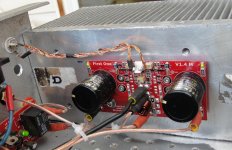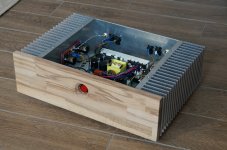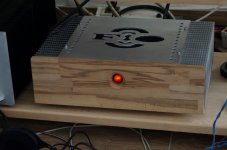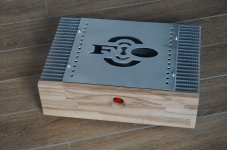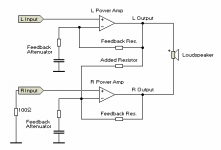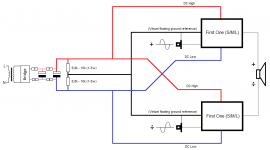Drain current limits:Thanks for the info Byrt.
So it seems like i have to use 3k/400 for the L modules, and the M modules only need the 180PS
- FO S - 8 Amax
- FO M - 16 Amax
- FO L - 32 Amax
Full balanced (bridged) amp makes load operates at double voltage so beware to exceed drain current limit, that's your guidance.

Great built Max, new home for FO.Now in use in the "patio" system for braking-in and eventual re-calibration, so no comments yet about sound.
Heatsink warm to the touch.
Some ugly pictures...
Thanks LC.

They like warm places, which makes them give out best.
P.S. Input wires makes me think .. also two bolts for the drivers not tighten (two more inside)?
Attachments
Last edited:
Link good info for bridging at Wikipedia https://en.wikipedia.org/wiki/Bridged_and_paralleled_amplifiers
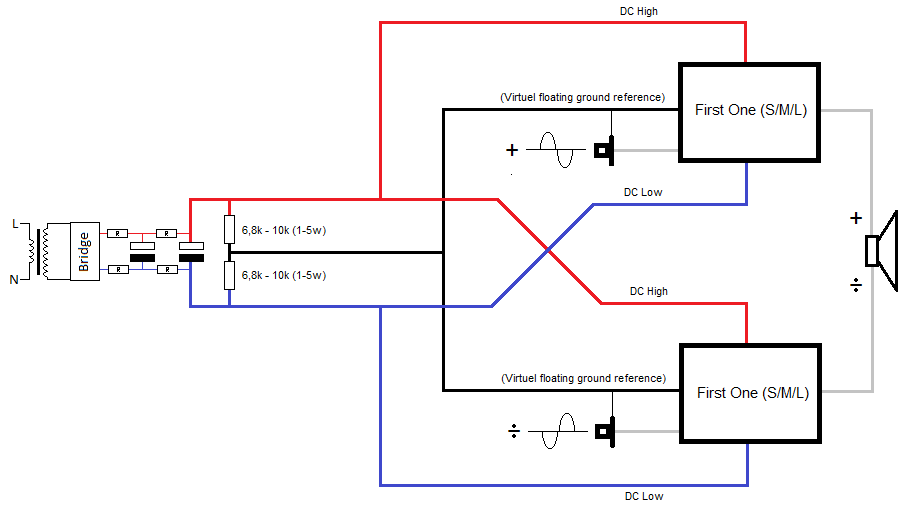
Thanks BYRTT, kind and helpful as always.

Great built Max, new home for FO.
They like warm places, which makes them give out best.
P.S. Input wires makes me think .. also two bolts for the drivers not tighten (two more inside)?
Thank you, dear LC, for your concern.
I ordered too long M3 bolts (16mm) and even after cutting them (very hard to do), some were still long so I added a nut on some and they appear to be loose. I double checked for "proper" torque.
The wires are my own braided (Litz) OCC copper enameled wire recipe. I decided to use them as hook-up internal wiring to keep the same flavor over the whole system...and they cost me almost nothing, safe a day to braid the cable.
Today, more listening with alternative speakers, humble Paradigm M3 re-capped, if my son lends them to me.
What a joy to build amps!
Thank you again for the opportunity.
Best wishes,
M.
Drain current limits:
- FO S - 8 Amax
- FO M - 16 Amax
- FO L - 32 Amax
Full balanced (bridged) amp makes load operates at double voltage so beware to exceed drain current limit, that's your guidance.
So if all 3 modules are used (S+M+L), then the drain is 56A? What do I compare this figure to on the SMPS3kA400?
So if all 3 modules are used (S+M+L), then the drain is 56A? What do I compare this figure to on the SMPS3kA400?
I dont think you can use the 400PS for the S boards.
4 pcs M and 2 L !
Smps3K/400 on 4 M boards and smps3k/700 on the 2 L boards
Any suggestion on signle ended to balanced converter ?
I suppose its not sound degrading if it has good components ?
It comes down to good circuit design as well...this here is strongly recommended or transformer coupled input:
THAT Receiver ?*Rev. 1.0
Best,
Anand.
Here are some Pics
Uaauuu. Really badass design. Respect.
Black Mamba on the way!
Building blocks prepared to be assembled into black Mamba chassis.
Building blocks prepared to be assembled into black Mamba chassis.
Attachments
-
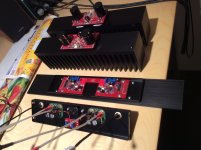 IMG_0602.jpg405.7 KB · Views: 634
IMG_0602.jpg405.7 KB · Views: 634 -
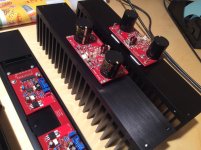 IMG_0603.jpg467.1 KB · Views: 621
IMG_0603.jpg467.1 KB · Views: 621 -
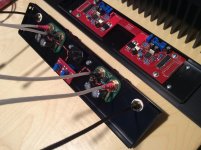 IMG_0604.jpg423.2 KB · Views: 251
IMG_0604.jpg423.2 KB · Views: 251 -
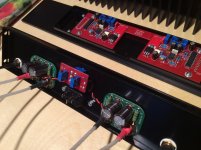 IMG_0605.jpg420.8 KB · Views: 223
IMG_0605.jpg420.8 KB · Views: 223 -
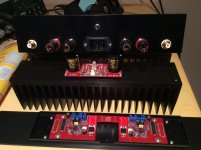 IMG_0607.jpg371.5 KB · Views: 229
IMG_0607.jpg371.5 KB · Views: 229 -
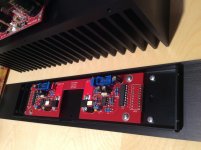 IMG_0606.jpg354.1 KB · Views: 209
IMG_0606.jpg354.1 KB · Views: 209 -
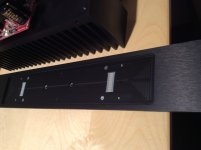 IMG_0608.JPG947.3 KB · Views: 230
IMG_0608.JPG947.3 KB · Views: 230 -
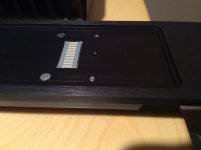 IMG_0609.JPG927.9 KB · Views: 200
IMG_0609.JPG927.9 KB · Views: 200 -
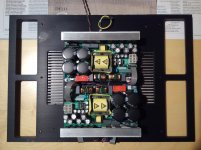 First One SMPS 1.jpg440.8 KB · Views: 300
First One SMPS 1.jpg440.8 KB · Views: 300 -
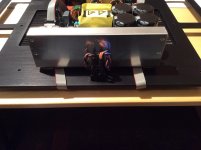 First One SMPS 2.jpg380.6 KB · Views: 295
First One SMPS 2.jpg380.6 KB · Views: 295
Any suggestion on signle ended to balanced converter ?
I suppose its not sound degrading if it has good components ?
THAT models linked by nycavsr2000 looks good, but wonder if below Rod Elliott circuit from ESP site Simplest Ever Bridging Adapter for Amplifiers can be build as the before suggested one with floating signal ground and floating non balanced power supply rails.
Thing with Rod Elliott circuit is it takes single ended input and few passive components to make it work and maybe more transparent than adding active converters. Lazy Cat will have to confirm if he thinks the add resistors to feedback network hack will work in his speedy FO amps.
To sum up if balanced pre signal is available build as the lower one with a non balanced smps or linear PSU and if only single ended pre signal is available still do the lower one but wire inputs as Rod Elliott's schematic.
From ESP site Simplest Ever Bridging Adapter for Amplifiers:
Attachments
Hi BYRTT
Thanks for the tip. I'll test this simplest ever bridging adapter with two First One modules, maybe next weekend.
Theoretically it is correct and it should work. I agree that this would be the most clear and transparent bridging adapter ever, without need of any messy electronic circuit in front of First One.
L.C.
Thanks for the tip. I'll test this simplest ever bridging adapter with two First One modules, maybe next weekend.

Theoretically it is correct and it should work. I agree that this would be the most clear and transparent bridging adapter ever, without need of any messy electronic circuit in front of First One.

L.C.

Building blocks prepared to be assembled into black Mamba chassis.
Dear LC,
Do you offer complete kits also?
That would help a lot...I am still trying to complete my case with dignity...
I never really understood the way your speaker protection works. It would be great if you can re-explain or link the explanation.
Thank you very much.
M.
Black Mamba chassis in preparation to be offered to anyone interested, will make announcement when kits are ready to be shipped.
DC sense module is a passive DC detector connected to shutdown input of any SMPS having this function. In a case of amp's failure it detects DC voltages greater than 1,5 V on amp's output terminals. When triggered, shutdown function of SMPS rapidly clamps its rails DC output to zero, meaning power amp module losses power immediately, so no damage could be done to the speakers. Great thing is that there's no output relay, no high amperage arc disconnections problems, when the sequence is started there's no turning back, no feedback dependency, no tripping or malfunction present, it goes down unstoppably.
DC sense modules spared me a lot of troubles during testing period, no FO modules were lost, no speakers burnt, so it's a great money saver and it deserves to be included in the system.
DC sense module is a passive DC detector connected to shutdown input of any SMPS having this function. In a case of amp's failure it detects DC voltages greater than 1,5 V on amp's output terminals. When triggered, shutdown function of SMPS rapidly clamps its rails DC output to zero, meaning power amp module losses power immediately, so no damage could be done to the speakers. Great thing is that there's no output relay, no high amperage arc disconnections problems, when the sequence is started there's no turning back, no feedback dependency, no tripping or malfunction present, it goes down unstoppably.
DC sense modules spared me a lot of troubles during testing period, no FO modules were lost, no speakers burnt, so it's a great money saver and it deserves to be included in the system.
When triggered, shutdown function of SMPS rapidly clamps its rails DC output to zero, meaning power amp module losses power immediately
Thank you, dear LC, for your detailed explanation. I still wonder what the path for discharge of module's main caps is...
Listening sessions began...this amp is like putting immense super-headphones! That detailed and textured it is! After listening Bartok's Violin concerto I can say: strings attacks and pizzicatti are lovely; drums attacks are fast and punchy ( You feel the leather being kicked); soundstage is huge, beyond speakers; bass is very deep but better, the images produced by the bass emitting instruments are proportionate to them; voices are fleshy...
VSSA is good but F.O. is on another league.
Thank you again, Master,
I have another question:
Can I use the technique of adding 10Ohm resistors to the power rails to calibrate iddle current instead?
I don't dare to use my lousy meter, which lack clamps, in series, for fear of disconnecting the power for one rail...
Best wishes,
M.
- Home
- Vendor's Bazaar
- First One - mosFET amplifier module
